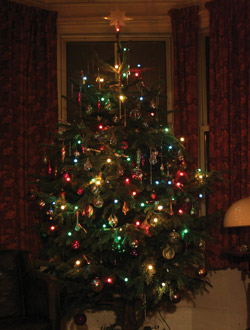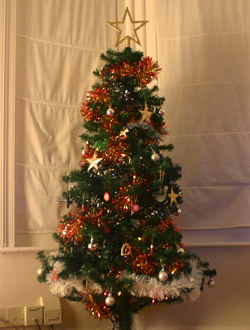Environmental Impact of Real and Artificial Christmas Trees
The first Christmas tree used in a winter Christmas celebration according to folklore was in Riga Lativa back in 1510. Some 420 years later the first artificial tree was created in 1930 from brush bristles, by US based Addis Brush Company.
Since then the age old debate has raged - which is better: a real or artificial Christmas tree? Recently the debate also includes, which is more environmentally friendly?
Below we list the main benefits of both choices with the most commonly asked questions regarding real and artificial Christmas trees.
Benefits When Using Real Christmas Trees
- Renewable Resource: Each Spring 2 or 3 trees are planted for each one cut down
- Recyclable: After Christmas the tree can be chipped, composted and used for ground cover
- Biodegradable: All real Christmas Trees are chemical broken-down by the environment
- Reducing Soil Erosion: Roots hold and wash the soil to make it fertile so it doesn't move
- Create Habitat for Wildlife: there are around 1 million acres of land used in Christmas Tree production throughout the US
- Sequestering Carbon: During the Christmas Tree's lifetime it removes carbon from the atmosphere
 How long does a Christmas Tree take to grow?
How long does a Christmas Tree take to grow?
Up to 16 years - the seedlings are around 3-4 years old when they are planted and can take another 7-10 years to produce a marketable tree.
What affect do the Christmas Trees have on the environment during this time?
The trees are absorbing carbon dioxide and provide the daily oxygen requirements for millions of people. On the downside the trees are subject to herbicides, pesticides and fertilizers during this time.
How many trees are sold in the US every years?
There are around 1 million acres of land used for Christmas Tree production in the US. Approx 34 million tress are sold every year in the US.
What happens to the trees after Christmas?
About 93% of trees used are recycled, generally by burning or they are chipped and spread over the garden.
What is the tree's carbon footprint when it is recycled?
They have a foot print of 3.5kg of carbon dioxide or the equivalent of toasting 418 pieces of bread and driving less than 10 miles.
Who is supporting the cause for people to use real Christmas Trees to lower carbon footprint?
'The Nature Conservancy' and the ' Carbon Trust' - a Government-funded company.
Benefits When Using Artificial Christmas Trees
- Reusable: Trees are used year after year and can usually last between 10-15 years
- Less Mess: Don't shed pine needles all over the floor
- Cost Effective: not having to pay out every year for a brand new tree
 The artificial tree has become very popular over recent years, especially given the current economic climate, but are people thinking about the impact their decision is having on the environment.
The artificial tree has become very popular over recent years, especially given the current economic climate, but are people thinking about the impact their decision is having on the environment.
What is an artificial tree's carbon footprint?
A six foot artificial tree's carbon footprint is 40kg of carbon dioxide if sent to landfill, at least 10 times more than a real tree, or the equivalent of toasting 5,222 slices of bread or driving 120 miles in an average-sized car.
Where are artificial trees produced?
Abroad, normally China, creating more carbon emissions with the additional transportation of the product.
What are artificial trees made from?
Polyvinyl chloride or PVC, which is a non-renewable petroleum-derived plastic.
What is the lifespan of an artificial Christmas Tree?
Most trees will last between 10-15 years, giving people a cost effective alternative to a real Christmas Tree.
What happens to the trees after Christmas?
They are either packed away for next year or sent to a landfill.
Who is supporting the cause for people to use artificial Christmas Trees to lower carbon footprint?
The American Christmas Tree Association sponsored a Carbon Footprint Study that found artificial Christmas Trees Best for the Environment.
Main Menu
Latest News
- Types of Trees Used
Both natural and artificial trees are used as Christmas trees....
- Fresh Christmas Tree
When a Christmas tree is cut, over half of its weight is water. With proper care, you can maintain th...

 Sales Tel.: 18675505823
Sales Tel.: 18675505823 Contact: Miss Hao
Contact: Miss Hao

 by Height
by Height